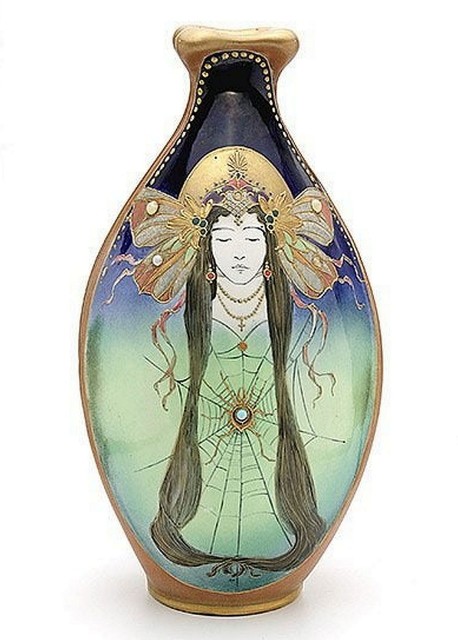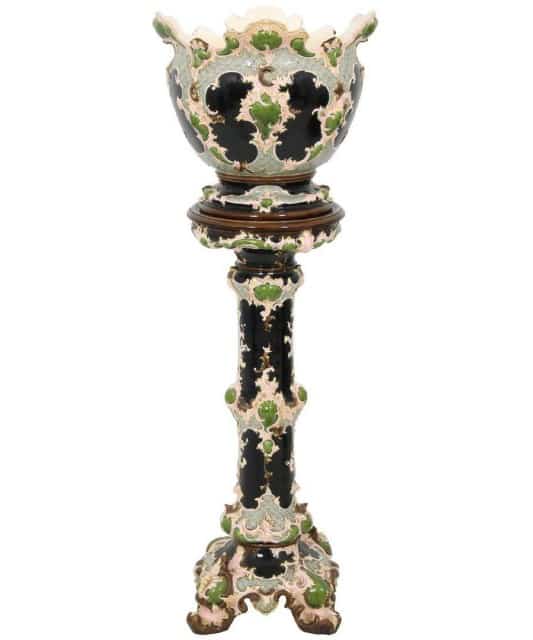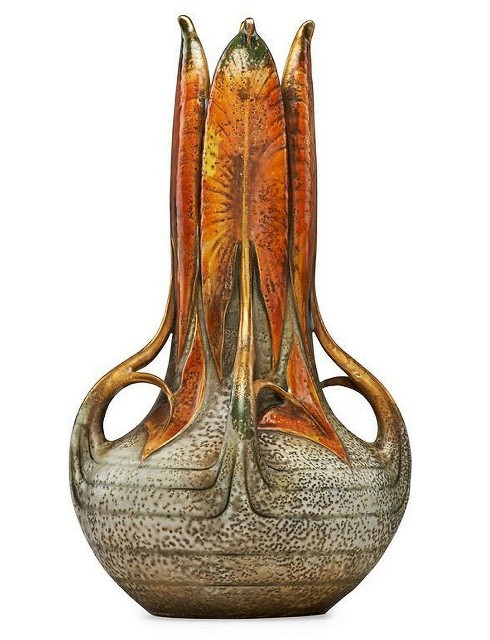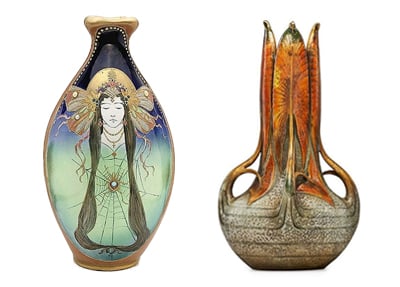
NEW YORK – When Chinese porcelain reached Europe in the 1300s, its durable, delicate beauty delighted aristocrats and royalty alike, despite its excessive cost. Prices dropped considerably in the 1700s, when German alchemist Johann Friedrich Böttger, facing deception, imprisonment, and court intrigue, replicated its secret formula. The key was kaolin—pure, white “China clay.” Across Europe, manufactories arose where abundant deposits were found. During the Art Nouveau era (circa 1890-1910), a period inspired by nature, the kaolin-rich Turn-Teplitz region (today Teplice in the Czech Republic) boasted up to 30 potteries and workshops of all types and sizes. These often merged, changed owners, shared designers, opened and closed.
In addition to drawing on historic porcelain traditions of nearby Meissen and Dresden, Teplitz potteries enjoyed a cooperative arrangement with a local institute, the Imperial Technical School for Ceramics and Associated Applied Arts. Potteries supplied it with raw clay, as well as expertise; the school reciprocated with a stream of talents trained in fine sculpture and modern, nature-inspired design.

Like architecture, graphics, interior design and other decorative arts of the time, Teplitz porcelain featured graceful, flowing line and organic, natural forms. Their applied reliefs, observed The Decorator and Furnisher (1889), in “warm subdued colors, golden brown prevailing, other hues being mainly deep red and gray, maroon and light green, claret and buff…so warm, so soft…” suggest an Asiatic origin. Indeed, Japonism, a wildly popular art movement, was also sweeping Europe.
In 1892, Alfred Stellmacher, owner of the Teplitz Imperial and Royal Porcelain Factory, encouraged family members, Riessner, Eduard Stellmacher and Kessel (RSt&K), to establish a firm of their own. Though its name, Amphora Porcelain Works, evoked images of ancient Greek storage vessels, the trio produced uniquely glazed, gilded figurines, ewers, bowls, vases, jardinieres and “drop edge candle vases” in innovative styles.

Paul Dachsel, a leading company designer, adorned soft-edged, simple forms with delicate, sculpted raindrops, pinecones, berries or gracefully draped autumn leaves. Eduard Stellmacher, on the other hand, adorned many of his creations with slithery naturalistic (or imaginary) snakes, lizards or dragons.
Producing complex, imaginative Amphora Porcelain was both painstaking and laborious. After sculpting models, then molding, fine-carving, hand-painting and glazing them, they were fired up to 10 before adding unique finishes and flourishes. Their designs, large or small, typically bore style numbers, artists’ marks and the word “Amphora” at their base.

Amphoras depicting hauntingly beautiful female faces, a la Mucha and Klimt, were particularly desirable. So were amazingly detailed, hand-finished, fashionable Amphora female busts, whether frilled, fanciful French courtesans or ravishing, mop-capped red-heads. Because larger busts were prone to breakage during production, these were rare and costly even at creation. Today, these century-plus beauties continue to charm.

By 1896, Amphora Porcelain Works was supplying “Imperial Amphora” to the imperial court in Vienna. By 1904, its stylish, superbly crafted pieces earned accolades at the Chicago and St. Louis world fairs. As a result. exclusive establishments, including Tiffany & Co., marketed them.
Though Paul Dachsel and Eduard Stellmacher soon departed Amphora Porcelain Works, the firm continued to operate under the name Reissner & Kessel Amphora Works. When Kessel left, it became Amphora Werke Reissner.
In the meantime, Ernst Wahliss, a leading Viennese porcelain retailer, had acquired Alfred Stellmacher’s pottery, renaming it Ernst Wahliss Kunst, Porzellan und Fayence Fabrik. At his death, his sons, purchasing hundreds of Vienna’s Imperial and Royal Porcelain Manufactory molds, renamed it Alexandra Porcelain Works Ernst Wahliss.

$400 + buyer’s premium in 2011. Image courtesy of Burchard Galleries and LiveAuctioneers
In addition to creating figurals, busts, bowls and vases, Alexandra Porcelain introduced the popular Serapis-Wahliss line, featuring figurines, covered boxes, cache pots, tea and coffee services adorned with trendy, brightly colored, geometric Secessionist-inspired motifs. Dachsel, now working alone, embellishing his works with similar nontraditional cabochons, cartouches and patterned floral motifs. His mark, an entwined “RD” and the words “Made in Austria,” reflect not only his changing style, but also the region’s changing borders.
Marked Teplitz pieces can be traced to a particular designer or pottery. Due to the area’s complex trade history, however, determining the origins of others may prove impossible.
Collectively, all are known as Teplitz.


